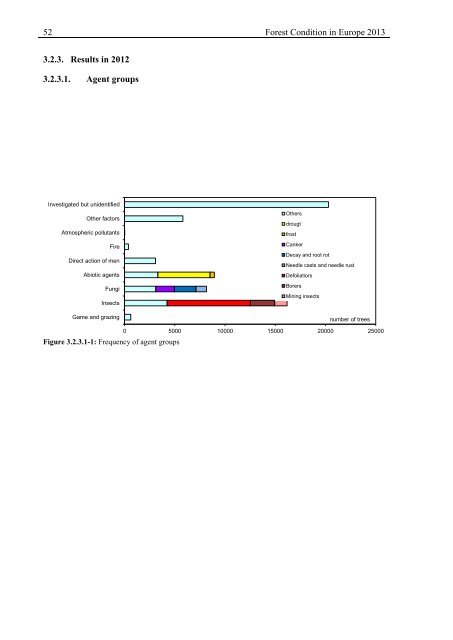Forest Condition in Europe - ICP Forests
Forest Condition in Europe - ICP Forests
Forest Condition in Europe - ICP Forests
You also want an ePaper? Increase the reach of your titles
YUMPU automatically turns print PDFs into web optimized ePapers that Google loves.
52 <strong>Forest</strong> <strong>Condition</strong> <strong>in</strong> <strong>Europe</strong> 2013<br />
3.2.3. Results <strong>in</strong> 2012<br />
3.2.3.1. Agent groups<br />
The distribution of the agent groups <strong>in</strong> 2012 shows that over 15 000 trees displayed symptoms<br />
caused by <strong>in</strong>sects (Fig. 3.2.3.1-1) correspond<strong>in</strong>g to 32% of the records (Tab. 3.2.3.1-1).<br />
Roughly half of the <strong>in</strong>sect-caused symptoms were attributed to defoliators and to the other<br />
half to borers and other <strong>in</strong>sects. Significantly fewer trees, namely over 11 000, displayed<br />
damage caused by fungi. In about 6 000 trees, an abiotic symptom (i.e. drought, frost) was<br />
found. Altogether, ca. 18 000 trees showed no signs of damage. Multiple agent groups were<br />
recorded for a number of trees. The damages due to air pollution refer to “direct smoke damages”,<br />
<strong>in</strong>direct effects were not assessed.<br />
Investigated but unidentified<br />
Other factors<br />
Atmospheric pollutants<br />
Fire<br />
Direct action of men<br />
Abiotic agents<br />
Fungi<br />
Insects<br />
Game and graz<strong>in</strong>g<br />
Others<br />
drougt<br />
frost<br />
Canker<br />
Decay and root rot<br />
Needle casts and needle rust<br />
Defoliatiors<br />
Borers<br />
M<strong>in</strong><strong>in</strong>g <strong>in</strong>sects<br />
number of trees<br />
Figure 3.2.3.1-1: Frequency of agent groups<br />
0 5000 10000 15000 20000 25000
















